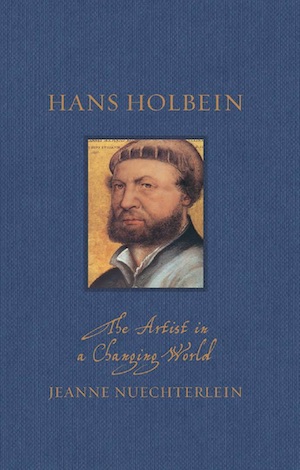By Svetlana Alpers
This is a very fine book about a puzzling artist. Page by page, sentence by sentence, Jeanne Nuechterlein brings the reader in and up close to the art. The author’s care and clarity in addressing the making of art is a match for Holbein’s art and skill. One learns a lot. It is a rare pleasure to find oneself right there as the artist makes an image. The compact trim size and design of the book are enabling.
I refer to Holbein as puzzling because he himself is insistently absent. We do not know many details of his life (such as when exactly he was born), nor do we know his attitudes towards the world, nor his intentions in producing works. We think of him, mainly perhaps, as the painter of The Ambassadors (1533), the memorable and puzzling double portrait with foreground anamorphic skull and scientific instruments now in the National Gallery, London. It is one of those puzzle pictures that art historians have been drawn to.
Holbein (1497/8-1543), the son of an artist, was born in Germany, worked in Switzerland and in England, where in the end he settled down with an appointment as a painter to the King. The changing world of the subtitle refers broadly to the protesting alternative Luther offered to the Catholic church, the tumultuous life and fortunes of Henry VIII, and budding scientific interests. But this artist was not deeply involved in the challenges of his age. He made adjustments and simply worked on. He began by designing images (though not actually cutting the wood or metal) for printed books, and painting religious works, and ended making singular portraits. One gathers that he was able to carry on in the midst of changing times because in a remarkable way his entire attention was on making his art. He was not much engaged with its relationship to, or use in, the world.
Take the case of his finely conceived (and here finely described) alphabet letters—majuscule letters intended to appear in Latin texts—which it turns out were rarely used in publications. Or the fact, insisted on here, that though Holbein represented the newest scientific instruments and added inventive images to newly devised maps, there is “little sense . . . that he had much intrinsic interest in the scientific content of his works.”
Holbein’s art is notably representational, one may say realistic in nature. That is a true pictorial accomplishment. However, the argument of the book is that it is only realistic at first glance because his painting consistently diverges from reality. On closer inspection the apparent naturalness breaks down. It is fascinating to be shown (or rather to be told, since it is hard to see such things in reproduction on a small page) that in the brilliantly realistic The Ambassadors a string on the lute is broken, the depicted geometry of the floor is imprecise, and the measurement scales of the astronomical instruments are inaccurate and often distorted. To what end? The suggestion is made that the painting reveals a certain despair about the project of the two men which was to bring about harmony between nations and religions. Befitting the artist, and the tone of this study of him and his work, that is put forward as a creative suggestion rather than offered as a conclusive interpretation.
In the unending fluctuations of life and position in the England of Henry VIII, Holbein was able to portray both an individual and the individual’s place in the public sphere. In this too, Holbein’s retreat from, or is it rising above, realism stood him in good stead. Nuechterlein is fine about how he dealt with social differentiation. She notes among other things his careful choice of pigments—pricey azurite and gold flakes for portraits of people at the top.
Holbein was a successful artist. But his ambition does not seem to have been huge. One thinks, by contrast, of his older (by almost thirty years) contemporary Albrecht Durer. And it is part of the grace of this book that the author is accepting of it. As she notes about his middling place in the hierarchy of royal artists, “his distinct skills were appreciated if not excessively so.”
A closing note. While the author often, and to good purpose, indicates the size of a particular work, this reader regrets that the publisher did not note the size (in the case of paintings) as well as the location of all the images reproduced in the book. Size is an essential aspect of every work of art and place is necessary to track a work down online or out in the world.
Reviewer Svetlana Alpers (ΦΒΚ, Radcliffe), an artist, critic, and renowned art historian, is professor emerita of the history of art at the University of California, Berkeley and a visiting scholar in the Department of Art History at New York University.




